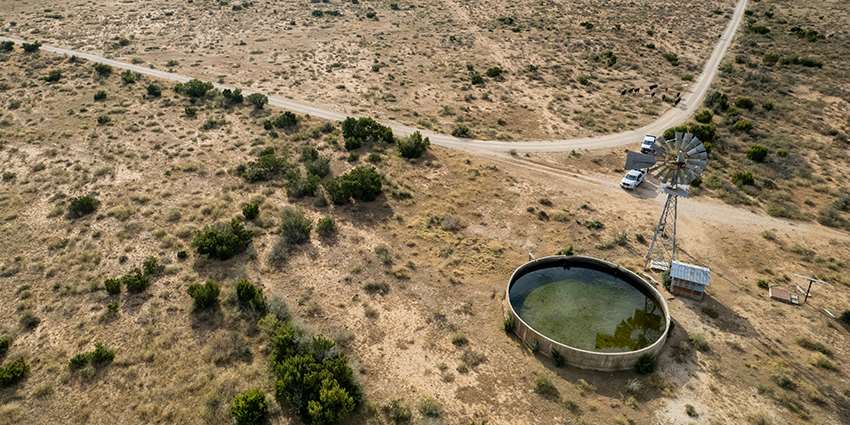Article originally written by Cameron Castilaw
A West Texas water well. (Sam Craft, Texas A&M AgriLife.)
Properly functioning private water wells are essential to quality of life for many rural Texans. Private wells ensure that residents’ home and agricultural water needs are met, and proper maintenance and upkeep are essential for long-term safe water use.
But learning the ins and outs of well maintenance and water quality can be daunting.
How do I test my well water? Why should I test my well water? How do I protect my well water quality in the future?
These questions are just a few of the many that Joel Pigg and his colleagues operating the Texas Well Owner Network (TWON) hear often.
“TWON is a Texas A&M AgriLife Extension educational program; we go around the state and screen water wells and then provide an educational component with it,” said Pigg, a Texas A&M AgriLife Extension Service program specialist. “We screen for coliform bacteria, E. Coli bacteria, nitrates, salinity or total dissolved solids (TDS), pH and arsenic as needed based on the area.”
Typical TWON events are two parts: well-owners bring in samples of their well water to be tested, and then they return at a later time to receive results and attend an educational workshop for well owners. TWON provides two different types of educational programs: Well Educated and Well Informed.
Well Educated workshops are usually half-day trainings where well-owners learn about water well specifications, aquifers, septic systems and water quality and treatment options. Well Informed trainings are one-hour meetings that cover proper well protection and water quality issues that would affect local residents.
Pigg encourages all well-owners to get their wells tested annually if possible.
“For general purposes, we suggest that you test for bacteria on an annual basis, for the rest of general the chemistry we say as needed,” Pigg said. “If you see a change in color, odor or taste of your well water, then we recommend that you get it tested to see what’s going on.”
Generally, Pigg said, out of 100 well samples TWON receives, on average about 15-20% test positive for coliform bacteria, 3-5% test positive for E. coli, and 5-8% test above drinking water standards for nitrates.
“People don’t think about there being bad things in their well water,” Pigg said. “It tastes good. It looks good. It’s like everything’s fine. We just don’t think about water until something happens.”
TWON is not the only program available to well-owners to get their water tested. Many counties have county health departments or groundwater conservation districts that offer testing services.
How Do I Take Care of My Well?
To prevent possible contaminants and keep wells safe, Pigg had a few tips for well owners:
- Have your well house or well location winterized in September or October. Texas weather can be unpredictable, and no one wants to have to go work on water when a cold front comes and lines freeze. “There’s nothing worse than being cold and wet,” he said.
- Keep your well house clean. Get debris off the floor. It’s not the location to store fertilizer bags or pesticide containers; old paint cans, all trash and other things need to be in another barn, not by your well. “A gallon of gas will kill a million gallons of drinking water,” Pigg said.
- Water issues are a case-by-case scenario. Neighbors can have different issues, even if they pull water from the same source. Issues like casing cracking within a system or even how far down a well is pulling water from can cause issues for one well owner that their neighbor does not have. “It’s really not a one-size-fits-all, because every aquifer is a little different,” he said.
- Check your filtration system and read up on your system’s service directions. Some well owners put in filtration systems due to water taste but forget to change the filter or service it properly, Pigg explains. “You can grow bad bacteria while meaning to do a good thing, you can accidentally do something bad.”
While sometimes issues outside of human control can cause issues for well health, getting the water regularly tested and general awareness can play a large factor in keeping both the water and consumers healthy.
“Wells are a $30,000-40,000 investment,” Pigg said. “Testing it now can potentially save you money later.”
To learn more about the Texas Well Owner Network, visit twon.tamu.edu.



